Origins of the German Coin Trade: The Hamburger and Schlessinger Families
To mark the auction of the Salton collection, Künker and Stack’s Bowers Galleries asked historian Ursula Kampmann to research the history of the Hamburger-Schlessinger coin trading dynasty. Her findings have revolutionized our knowledge of the German coin trade.
Mark Salton (1914-2005), who built up a very impressive coin collection
together with his wife Lottie (1924-2020), was descended from arguably the
most important dynasty of German coin dealers before the First World War.
Behind the American name Mark Salton was actually Max Schlessinger, son of
Felix Schlessinger (1879-1944), who was himself a nephew of Leo Hamburger
the younger (1846-1929). Leo Hamburger the younger, in partnership with his
cousin Leo Hamburger the elder (1836-1902), built up the most important
German coin dealership of the pre-1914 era.
Origins
We can trace the origins of the Hamburger family back to the Jewish ghetto of Hanau, where Loeb Hamburger (approx. 1730-1804) worked as a court factor. This job didn’t leave him with any kind of fortune. He earned just enough capital to provide his daughters with a dowry and to finance an excellent education for his three sons. Joseph (1801-1866) trained as a wholesaler, Jakob (1803-1884) became a rabbi, and Julius (1806-1887) became a lawyer. Joseph and Jakob opened a profitable intermediary business together in Hanau. Their business thrived until the construction of the railway, which changed the rules of the game. Suddenly, factory owners were sending their own agents, while Hanau’s retailers started buying their goods in Frankfurt, where they had a greater selection to choose from.
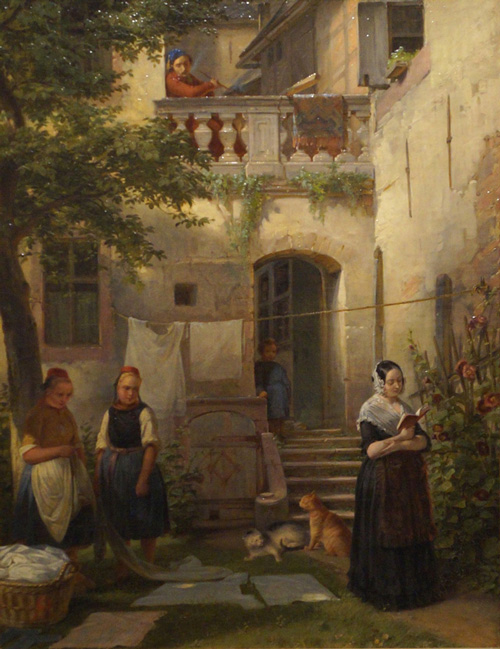
“Der Bleichgarten” (“Bleaching green”), a painting by Moritz Daniel Oppenheim, which probably reflects an authentic place in the ghetto of Hanau. Painted at a time when the Hamburger family was living there.
These business difficulties had a concrete impact on the life of Joseph Hamburger’s eldest son Leo. Namely, his father could not to pay an apprenticeship premium for his son. He was grateful when a friend arranged an apprenticeship for the fourteen-year-old Leo free of charge, at the Jewish bank Oberndörffer in Munich.
Leo Hamburger the Elder
Now, the Oberndörffer bank not only focused on financial matters – it also operated several coin dealerships. This is how Leo Hamburger ended up training under Abraham Merzbacher (1812-1885), father of the much better-known coin dealer Dr. Eugen Merzbacher (1845-1903). Leo made such excellent progress that, after completing his apprenticeship, he was entrusted with the task of managing the Vienna branch of the Oberndörffers’ business. In 1861, Leo Hamburger founded his own coin dealership, initially in Vienna, before relocating it to Frankfurt just two years later. From that point on, this coin dealership represented the most important source of income for the Hamburger family, and many of the family’s members found work there.
Leo Hamburger the Younger
Among these family members was Leo Hamburger the younger, cousin of Leo Hamburger the elder. Leo Hamburger the younger was the youngest son of Jakob, who was the business partner and brother of Joseph, Leo Hamburger the elder’s father.
We don’t know what kind of training the younger Leopold Hamburger had. In
any case, he bought into his cousin’s coin dealership as a partner, using
the dowry of his wife Meta Feuchtwanger to do so. This marriage was
probably arranged by Leo Hamburger the elder himself. He had met and grown
close to the Feuchtwanger family during his apprenticeship in Munich.
From 1889 onward, the two cousins held regular auctions under the name L. & L. Hamburger. The collections sold there, such as those compiled by Prince Alexander of Hesse, Ercole Gnecchi, Carl Friedrich Pogge, Paul Stroehlin, and Hans Wunderli von Muralt, illustrate the significant role that the L. & L. Hamburger auction house played in the German coin trade before the First World War.
The research into the Hamburger-Schlessinger coin trading dynasty suggests that marriage ties could have played a crucial role in the establishment of German coin dealerships. One secondary finding of the research may prove to be key evidence of this: a mutual cousin of the two Leo Hamburgers married Adolph Hess, who was probably the founder of the coin dealership of the same name, which he relocated to Frankfurt in 1871.
A Struggle for the Inheritance
On February 12, 1902, Leo Hamburger the elder died. His partner, Leo Hamburger the younger, continued to run the shared business until his claim to the inheritance was disputed by the eldest son of Leo Hamburger the elder, named Joseph after his grandfather. In the course of a very unpleasant court case, it was established that Joseph Hamburger was entitled to the residential building where L. & L. Hamburger had previously been based, while Leo Hamburger was given the company’s complete stock and library. Both Joseph and Leo Hamburger continued to run their own coin dealerships until their respective deaths.
The Joining of the Hamburger and Schlessinger Families
The Hamburger and Schlessinger families were connected by a marriage. Röschen (1844-1932), the older sister of Leo Hamburger the younger, married the banker Max Schlessinger (1835-1896), whose kind nature is attested by the memoirs of his daughter Sophie (1880-1972). Sophie also paints us a vivid picture of her older brother Felix – the future coin dealer Felix Schlessinger (1879-1944). She portrays him as a temperamental, intelligent, and witty young man, who found himself in a similar predicament as Leo Hamburger the elder: his father Max died far too soon of cancer on June 4, 1896. With that, the family lost their breadwinner and 17-year-old Felix lost the prospect of his father’s support in establishing a livelihood for himself.
But an opportunity presented itself to Felix in the form of another, far worse tragedy: in 1904, the only son of Leo Hamburger the younger took his own life – due to heartache, according to family rumours. Leo Hamburger took the penniless eldest son of his sister Röschen into his home, so that he could one day take over his coin dealership.
Felix Schlessinger
Felix Schlessinger’s story would make fantastic material for a screenwriter. His character was shaped by a combination of bravery, responsibility, and a generous helping of chutzpah. Felix was the very model of a spirited German officer, to such an extent that he was among the tiny minority of Jewish conscripts to be appointed to the rank of non-commissioned officer.
Likely through the mediation of Leo Hamburger the younger, Felix married Hedwig Feuchtwanger, a cousin of the famous writer Lion Feuchtwanger. In connection with this marriage, Leo Hamburger the younger made Felix Schlessinger his partner, along with his son-in-law David Nussbaum.
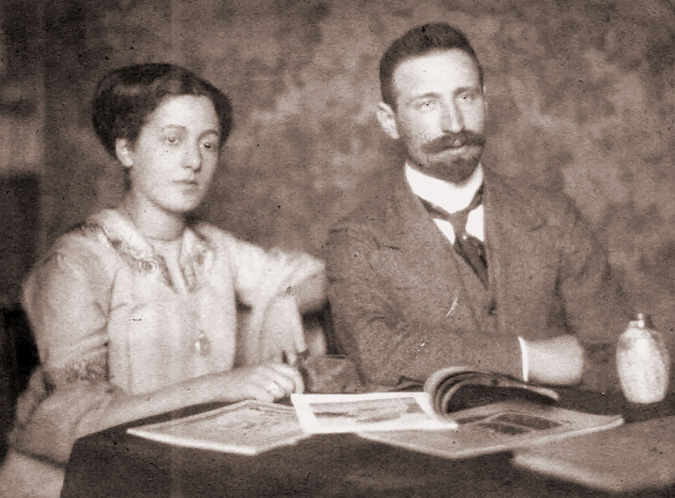
Felix and Hedwig Schlessinger
During the First World War, Felix Schlessinger served on the front line as a reserve non-commissioned officer. He fought in the Battle of Verdun, was wounded, buried alive, and awarded the Iron Cross for his courage.
Felix’s personality is perhaps demonstrated by this characteristic episode recalled by his sister Sophie: Ernst Wachtel, the husband of Felix’s eldest sister Rosalie had been sentenced – rightly or wrongly, that remains undecided – to several years in prison for “Wehrzersetzung” (subversion of the war effort). He was imprisoned at Landeszuchtanstalt Münster, where he almost starved to death due to the unbearable food shortages. In 1918, the war ended. Sophie writes: Only those who lived through that time can imagine the chaos that the followed the end of the war. There were workers’ councils and soldiers’ councils and everything was going haywire. Felix, as a discharged soldier, went with two of his comrades to the prison in Münster in Westphalia, where Ernst was serving his sentence, and demanded the immediate release of the prisoner, and it worked.
After the war, Felix Schlessinger returned to Frankfurt, where the coin dealership – like the German coin trade as a whole – suffered enormous losses during the period of hyperinflation. At that point, Leo Hamburger the younger was so old that he could no longer understand reality. As a result, by 1923, the most famous coin dealership in Germany was more or less bankrupt. The business that Felix Schlessinger was once supposed to inherit no longer existed. So, Felix decided to go to Berlin to start his own coin dealership there. This was a great success. Among his most important auctions was that of the “doublets” from the Hermitage Museum.
The End of the Jewish Coin Trade in Germany
And then, Paul von Hindenburg appointed Adolph Hitler as Reich Chancellor. Since Felix Schlessinger’s coin dealership, like many other Jewish-owned auction houses, was an important means of securing foreign currency for Germany, the business remained intact until May 1936, when a new law was passed that essentially banned Jewish coin dealers from working. It forced Felix Schlessinger, along with his wife and two sons, to emigrate to Amsterdam. In doing so, he lost his entire fortune, but he managed to save the library and – after months of investigation by the Reichsbank – his inventory of coins.
Once again, Felix Schlessinger built a new life for himself. He held a series of auctions at his Amsterdam coin dealership and provided his son Max with the means to open his own coin dealership at Leidsche Kade 83.
But on May 10, 1940, the German Wehrmacht invaded the Netherlands, Belgium, and Luxembourg. A German government was installed, which not only confiscated Felix Schlessinger’s coin dealership, along with his library and inventory, but also deported Hedwig and Felix Schlessinger, sending them first to Westerbork transit camp, then to Theresienstadt concentration camp, before murdering them in the gas chambers of Auschwitz on October 25, 1944.
Max Schlessinger Becomes Mark Salton
Max and his brother Paul, 26 and 22 years old respectively at the time, managed to escape. Mark Salton described his daring escape himself in his memoirs: some Dutch friends hid him from the Nazi thugs in Amsterdam, after which he made his way across France – first occupied France, then Free France – to the Pyrenees. He crossed the mountain range on foot, in forced marches, to surrender himself to the Spanish authorities in northern Spain. He was imprisoned in the concentration camp of Miranda de Ebro until the Dutch embassy in Madrid organized his departure to Portugal.
The Dutch embassy in Lisbon offered the multilingual Max Schlessinger a job. He probably would have become a high-ranking diplomat in the Netherlands if he hadn’t decided to emigrate to the USA after the end of the Second World War.
When he arrived there, he adopted the name Mark Salton. He married the young Lottie Aronstein, who had suffered a fate similar to his own, within just three months of meeting her. Lottie had fled with her father and little brother shortly after the November pogroms and, after an odyssey halfway around the world, arrived in New York, where she earned her living as a diamond cutter.
Building the Salton Collection
Mark Salton may well have toyed with the idea of making a living in the coin trade, as his father had before him. In the 1950s, he was a familiar face in all American and European coin dealerships. He published a few fixed price lists, but they were published only in tiny numbers.
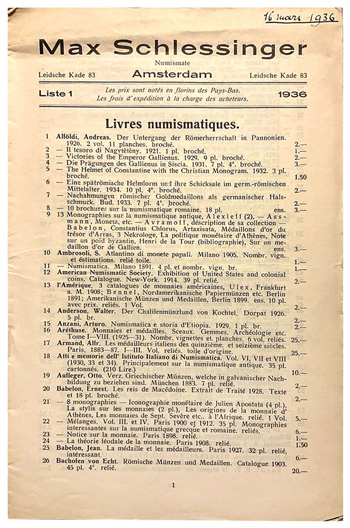
Max Schlessinger’s first fixed price list, dated 1936
But just shortly after his arrival, Mark Salton found work as an analyst in the international department of Manufacturers Hanover Trust Company, one of the largest banks in New York at the time. He built up such a successful career that coin trading was no longer necessary. In 1966, he and his wife went to Rome for several years to run the Italian branch of Manufacturers Hanover Trust. During this time, the couple turned from dealers into collectors, with a particular interest in the art form of medals.
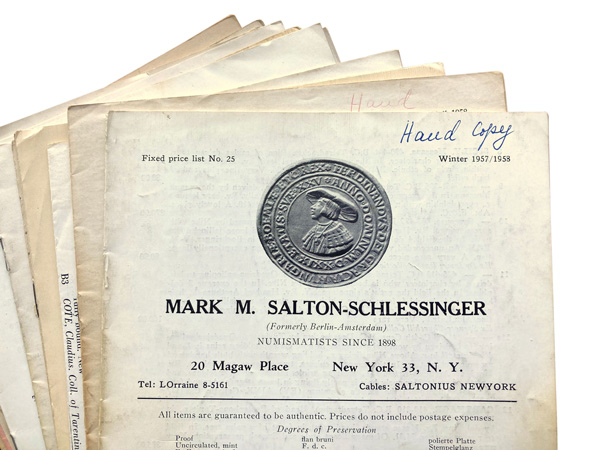
Fixed price lists published by coin dealer Mark M. Salton-Schlessinger
Mark Salton died after a fulfilled life on December 31, 2005, at the age of
92. He was followed in death by his beloved wife Lottie Salton, née
Aronstein, on April 18, 2020.
The couple leaves us with a moving testament to the fact that, despite even the most terrible experiences, it is possible to start over. They decided to donate the proceeds from their collection to organizations that commit themselves to the remembrance of the victims of the Holocaust, to ensure that their fate is hopefully never repeated.
It is a great honor for Künker and Stack’s Bowers Galleries that Lottie and Mark Salton have stipulated in their will that their numismatic collection be auctioned by the two auction houses in the USA and Germany. Künker has published a brochure in English and German detailing the story of the Hamburger, Schlessinger, and Aronstein families, as researched by Ursula Kampmann. You can view this brochure online (https://www.kuenker.de/data/kataloge/Kuenker_Broschuere_Salton-Collection_en.pdf) or order a copy from Künker for a nominal fee of 10 euros.
Auction dates for the Salton Collection
|
Part 1 |
Ancient Greek/Polish/Russian coins |
January 16, 2022, New York, at the New York International Numismatic Convention |
Stack’s Bowers Galleries |
|
Part 2 |
European gold coins |
March 22, 2022, Osnabrück |
Künker |
|
Part 3 |
England |
August 2022, Chicago, at the ANA World’s Fair of Money |
Stack’s Bowers Galleries |
|
Part 4 |
Ancient Roman/Byzantine coins |
September 2022, Osnabrück |
Künker |
|
Part 5 |
Ancient Greek/English coins |
January 2023, New York, at the New York International Numismatic Convention |
Stack’s Bowers Galleries |
|
Part 6 |
European silver coins |
January 2023, Berlin, at the World Money Fair |
Künker |

Download the Greysheet app for access to pricing, news, events and your subscriptions.
Subscribe Now.

Subscribe to The Greysheet for the industry's most respected pricing and to read more articles just like this.
Subscribe Now.

Subscribe to CPG® Coin & Currency Market Review for the industry's most respected pricing and to read more articles just like this.
Source: Fritz Rudolf Kuenker GmbH and Co. KG


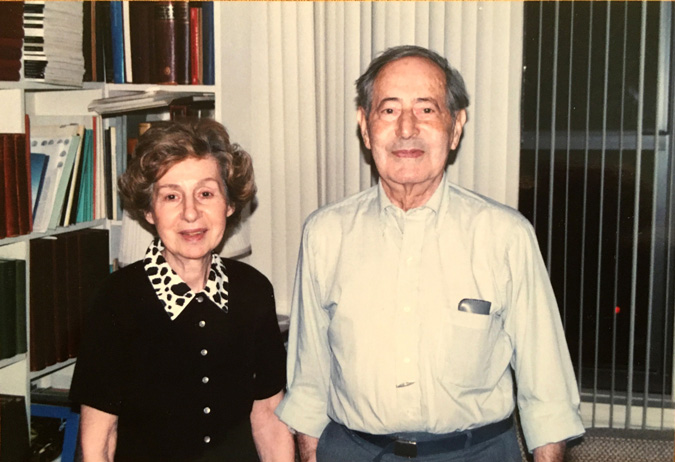






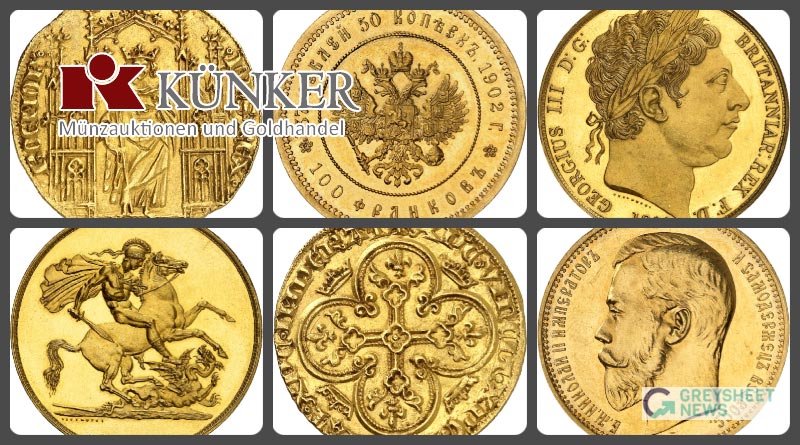
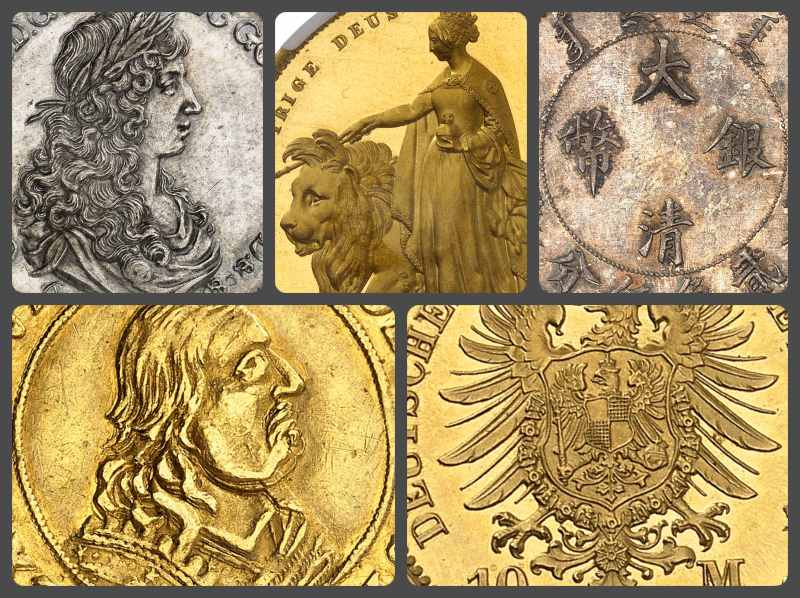

Please sign in or register to leave a comment.
Your identity will be restricted to first name/last initial, or a user ID you create.
Comment
Comments